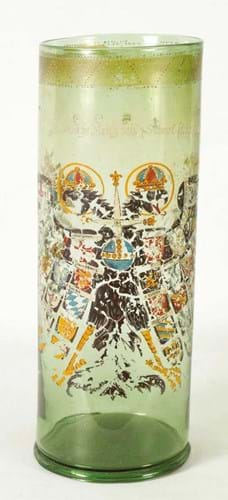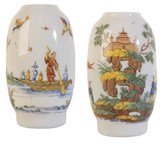Making them was something of a rite of passage for the glassmakers of Bohemia, Saxony, Thuringia, Hesse and in the Fichtel Mountains. Some guilds demanded the production of an eagle tankard in one and a half days as a masterpiece.
In early examples (the oldest known from 1571 is now on display at the British Museum) the eagle is depicted with a cross or an image of the crucifixion to symbolise the Christian basis of the Holy Roman Empire.
The best of these have, in the past, sold for as much as £20,000-30,000 in sales in Europe.
From the beginning of the 17th century, an orb or a portrait of the emperor Leopold I (1658-1705) would often take the place of the crucifixion scene.
The example in green glass offered as the second lot in a mammoth sale at Hutchinson Scott (25% buyer’s premium) in Skipton on March 28-31 was of this type. It carried the date 1599. The 16in (39cm) vessel was intact, but the enamel was heavily worn with losses of perhaps 30-40 per cent. The hammer price was £1500.
Forging ahead
Not every reichsadlerhumpen that comes to market is of the period. At the end of the 19th century, when 16th and 17th century glass was changing hands for very substantial sums, these tankards were often forged and enamelled with spurious dates and inscriptions.
The example offered at Mitchells (25% buyer’s premium) in Cockermouth on March 22 was probably one of these historicist pieces. It carries the date 1624 to the reverse.
The tankard was, nonetheless, finely decorated and in perfect condition apart from some rubbing to the gilt rim. Estimated at £100-200, it took £1600 via thesaleroom.com.















